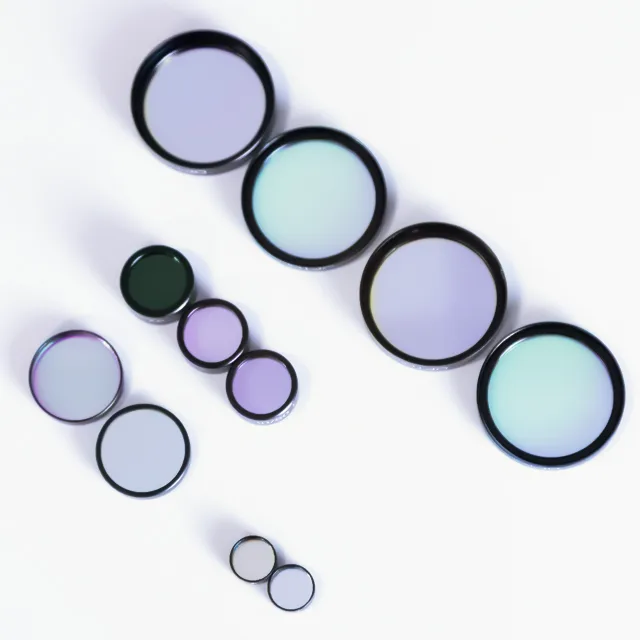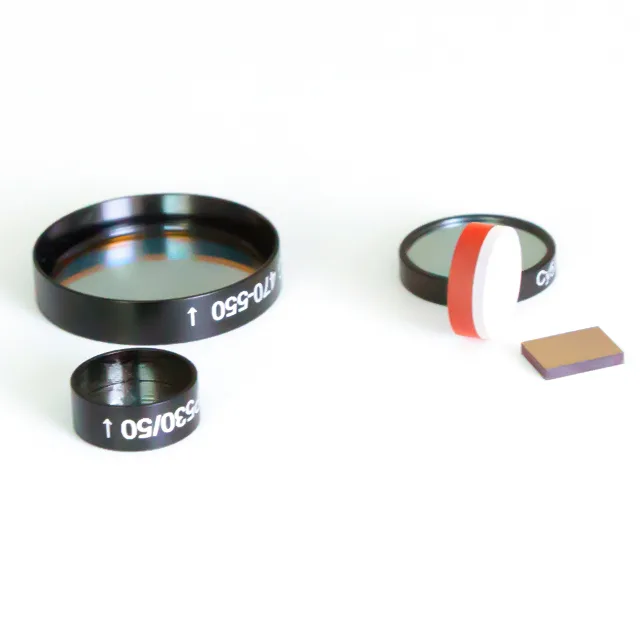Beam splitters come in many different forms, including cube and plate configurations, each with its own unique characteristics and applications.
Beamsplitters are good at splitting incoming light in specified ratios, and they are required to precisely control light intensity in experiments and measurements.
In this article, we will take an in-depth look at the types, applications, and working principles of beam splitters to understand their importance in optical systems.
What Is a Beam Splitter
A beam splitter is an optical device that splits a single beam of light into two separate beams, usually a transmitted beam and a reflected beam.
Common beamsplitters include T30/R70, T50/R50/ and T70/R30, and some manufacturers provide customized services. They can customize the beam splitter to fit your application.
Characteristics of Beam Splitter
Beam splitters usually have the following characteristics:
Optical coating: Beamsplitters have specialized optical coatings. The coating is engineered to achieve the required reflectivity and transmission, allowing the beam splitter to efficiently split incident light into transmitted and reflected beams.
Durability and Stability: Another noteworthy feature is the durability and stability of the beam splitter. These devices are engineered to withstand varying environmental conditions, including temperature fluctuations and mechanical stress.
WavelengthCompatibility: Beam splitters are customized to be compatible with specific wavelengths of light to meet the requirements of different applications. This wavelength compatibility ensures efficient splitting and combining of beams without compromising precision or accuracy.
Polarization Sensitivity: Beam splitters exhibit polarization sensitivity as a distinctive feature. This means they interact differently with polarized light, providing opportunities for polarization-based experiments and measurements in optical systems.
Customizability: Beam splitters like Optolong support customization and can effectively meet some special experimental or industrial needs.
Different Types of Beam Splitters

Beamsplitters come in several different types with unique characteristics that meet specific optical requirements. Let’s explore the various types of beam splitters commonly used in optical systems.
Plate Beam Splitter
Plate beam splitters are a popular type of beam splitter characterized by their flat plate-like structure. They can effectively separate incident light through this structure.
These beam splitters use a specially designed multi-layer film system to reflect part of the light and transmit the rest on the flat panel, thereby controlling the light path and intensity.
Cube Beam Splitter
Cube beam splitter is a structure with a cube shape and its working principle is similar to that of a plate beam splitter. However, its compact design allows for more efficient use of space within the optical setup.
Cubic beamsplitters are favored in applications where optical path lengths are minimized, such as in compact interferometers and imaging systems.
Polarizing Beam Splitter
A polarizing beam splitter separates light into two orthogonal polarization components based on the polarization state of the incident light. This device mainly uses birefringent crystals or special thin film coatings to achieve polarization separation, so that light wave energy in different polarization directions is transmitted and reflected separately.
Dichroic Beam Splitter
Dichroic beamsplitters are specifically designed to divide incoming light based on its wavelength. They do this by selectively reflecting or transmitting certain wavelengths while allowing others to pass.
This feature makes dichroic beam splitters ideal for applications involving multi-wavelength imaging, fluorescence microscopy, and spectroscopic analysis.
We also introduced the difference between dichroic mirrors vs beamsplitters in our previous article, if you are interested, please read it.
Applications of Beam Splitters
Beam splitters contribute to progress and innovation in various industries. Their versatility and precision lend themselves to numerous applications, each utilizing the unique capabilities of the beam splitter to achieve specific goals:
Microscopy
In the field of microscopy, beam splitters can effectively promote imaging technology. By effectively splitting the beam, multiple samples or different imaging modes can be observed simultaneously.
Dichroic beam splitters are used to separate excitation and emission wavelengths, thereby enhancing visualization and analysis of biological samples.
Interferometry
Interferometers rely on the precise manipulation and combination of light beams to generate interference patterns used for measurement and analysis. Beam splitters help guide and recombine light paths in interferometry setups, enabling accurate evaluation of optical components, surface profiles, and material properties.
Their ability to maintain beam integrity while splitting and recombining light rays allows for reliable interferometry results.
Telecommunications
In telecommunications systems, fiber optic beam splitters facilitate efficient distribution and routing of optical signals. These devices enable seamless separation of signals within fiber optic networks and support various functions such as signal monitoring, network testing, and wavelength division multiplexing.
The reliability and performance of beam splitters contribute to the smooth operation of telecommunications infrastructure, ensuring optimal signal transmission and reception.
Spectroscopy
Spectroscopy techniques benefit from the use of beam splitters to separate light into different spectral components. Dichroic beamsplitters are particularly valuable in multiwavelength spectroscopy applications, where they can analyze different wavelengths simultaneously with high precision.
By selectively reflecting or transmitting specific wavelengths, these beamsplitters improve the accuracy and efficiency of spectral measurements across different scientific disciplines.
How Does It Work?
Beam splitters work by using specialized optical coatings and precise design configurations to split an incoming beam into transmitted and reflected parts.
They control the distribution of light according to the angle of incidence as well as the wavelength and polarization of the light, and they enable optical technology applications with precise control of the light path.
How to Clean or Maintain the Beam Splitter?

Proper maintenance and cleaning of beamsplitters ensures optimal performance and longevity of the beamsplitter in the optical system. Here are some guidelines for effective maintenance and cleaning of this important optical component:
Periodic Inspections: Inspect the beam splitter regularly to identify any signs of wear, damage, or contamination. Inspect optical coatings for scratches, cracks or degradation, which may affect their reflective and transmissive properties.
Gentle Cleaning Procedure: When cleaning the beam splitter, a gentle cleaning procedure must be used to avoid damaging the delicate optical surfaces. Start by removing any loose particles or dust from the beam splitter surface using an air brush or compressed air. Avoid using excessive force during this step to prevent scratching or dislodging the optical coating.
Optical-grade solvent: For more stubborn contaminants, such as fingerprints or smudges, use optical-grade solvent designed for cleaning precision optics. Apply a small amount of solvent to a lint-free microfiber cloth and gently wipe the surface of the beam splitter in a circular motion. Use caution to avoid excessive pressure that may cause damage.
Avoid the use of abrasive materials: Under no circumstances should abrasive materials such as paper towels, paper towels, or rough cloths be used to clean the beam splitter. These materials can cause scratches or abrasions on sensitive optical surfaces, resulting in reduced performance and impaired light transmission.
Handling Precautions: When handling beam splitters, be careful to observe proper precautions to prevent contamination from oil, dirt, or debris on your hands or work surfaces. Wear lint-free gloves when necessary and store the beamsplitter in its protective box when not in use to minimize contact with environmental contaminants.
Environmental Considerations: Store the beamsplitter in a clean, dry environment away from direct sunlight and extreme temperatures. Over time, exposure to harsh environmental conditions degrades the optical coating and structural integrity of these components.
By adhering to these maintenance practices and cleaning guidelines, users can ensure that their beamsplitters continue to provide reliable performance in a variety of optical applications while extending their service life.
Conclusion
In summary, beam splitters are important optical devices that help manipulate light in countless scientific and industrial applications. By utilizing different types of dichroic, polarizing, plate, or cubic beam splitters, these devices can meet the specific needs of systems ranging from spectroscopy to lasers.
Understanding the relevant knowledge points of these beam splitters can help you make a better choice for your industry or application.
If you’re looking for a high-quality beam splitter, consider Optolong. We can customize a beam splitter for your application! Click here to contact us!
